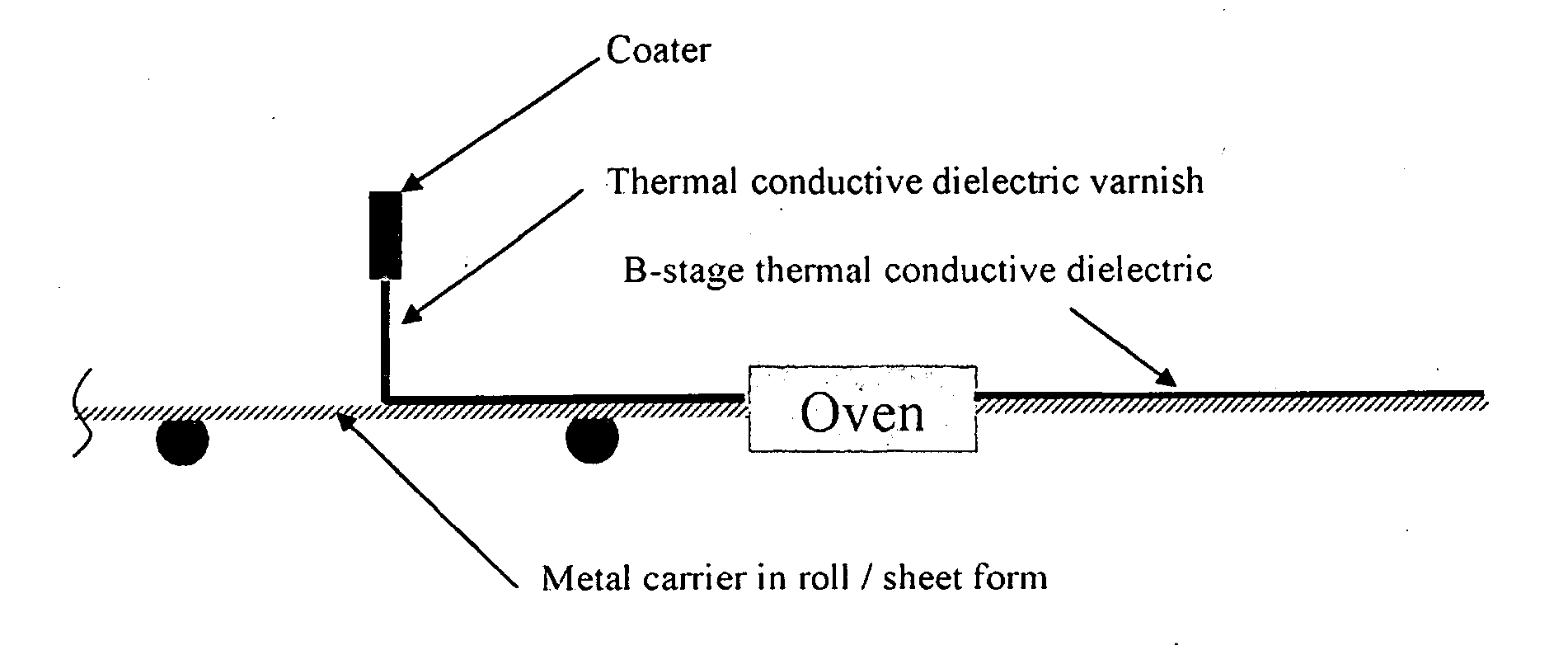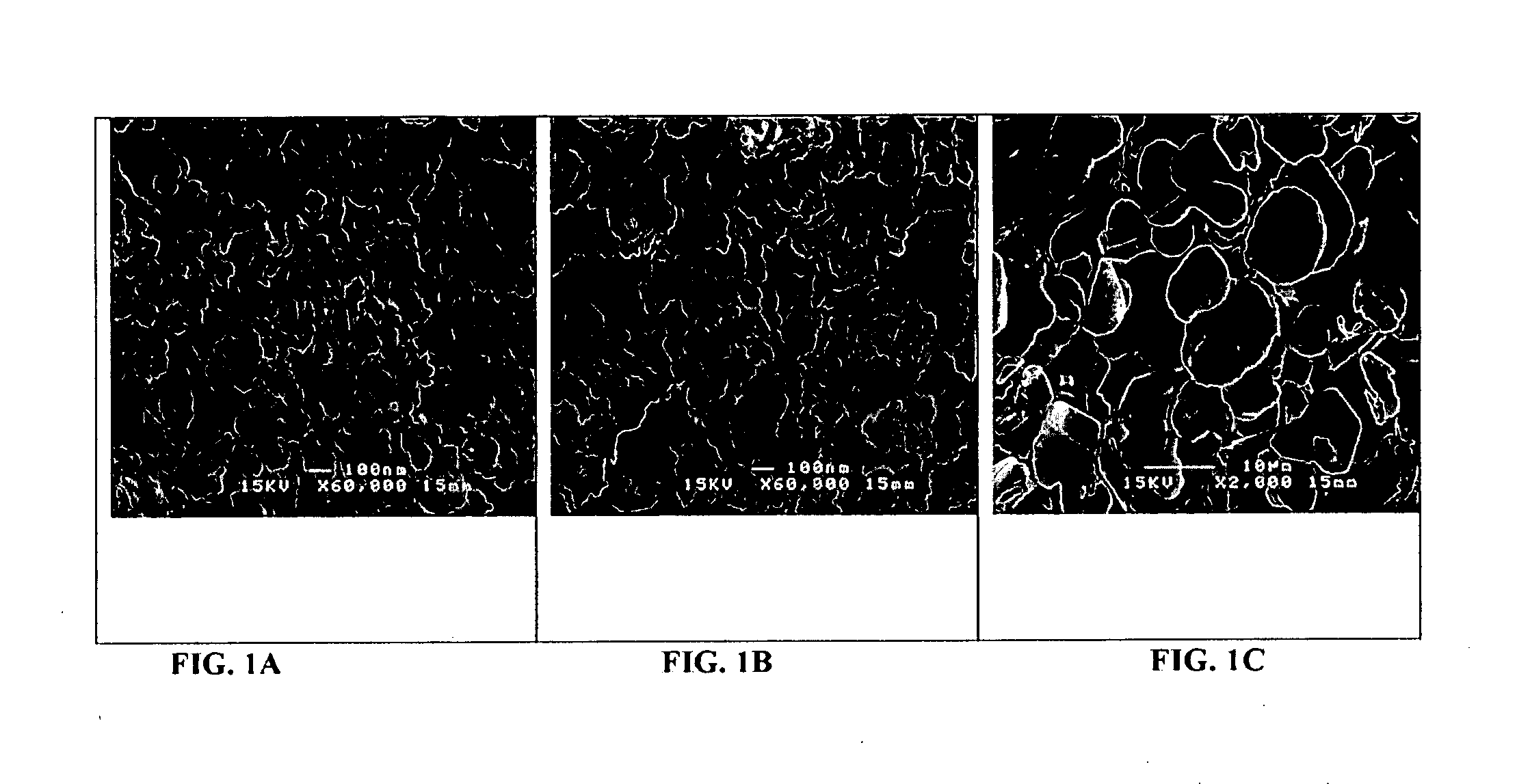B-stage thermal conductive dielectric coated metal-plate and method of making same
- Summary
- Abstract
- Description
- Claims
- Application Information
AI Technical Summary
Benefits of technology
Problems solved by technology
Method used
Image
Examples
example 1
Preparation of a B-stage B—N-Filled Thermal Conductive Dielectric Coated Metal-Plate
[0066]The following system was chosen for its low viscosity to ensure good dispersion and improved interface between filler and epoxy matrix: brominated difunctional epoxy EP8008 and tetrafunctional epoxy EP1031 (both from Huntsman) were used as epoxy resin components. Dicyandiamide (from Neuto Products) was used as a hardener, and 2-methylimidazole (from Tokyo Kasei Kogyo) was used as an accelerator. Shin-Etsu KBM-403, 3-glycidoxypropyltrimethoxysilane was used as coupling agent. Boron nitride (from Zibo ShineSo and Momentive Performance Materials Quartz) was used as the filler. The B—N filler had a size of either,53 nm, 0.15 μm or 4 μm (AC6004), as depicted in FIGS. 1A to 1C, respectively.
[0067]A process flow for fabricating a B—N-filled thermal conductive dielectric coated metal-plate is depicted in FIG. 2. In this example, the desired volume fraction of boron nitride was mixed with a 1% (with res...
example 2
Preparation of a C-Stage B—N-Filled Thermal Conductive Dielectric Coated Metal-Plate
[0069]In this example, the C-stage B—N-filled thermal conductive dielectric coated metal-plate was fabricated by laminating the B-stage thermal conductive dielectric coated copper foil of Example 1 with another copper foil in a vacuum presser at about 175° C. for about 2.5 hours. The process for preparing a C-stage aluminium nitride-filled dielectric coated metal-plate was the same as that of the boron nitride, except that the boron nitride was replaced with aluminium nitride.
example 3
Thermal Conductivity of B—N Filler-Loaded v. Al—N Filler-Loaded Dielectric Layers
[0070]In this example, the thermal conductivities of the filled thermal conductive dielectric layers of Example 2 were measured. As shown in Table 1, the B—N-filled dielectric layers exhibited higher thermal conductivity than the Al—N-filled dielectric layers for the loadings tested. It was attributed to boron nitride formed thermally conductive networks at lower filler content than aluminium nitride and boron nitride's relatively high inherent thermal conductivity in comparison with aluminium nitride. Consequently, a comparatively low amount of B—N was enough to achieve a high thermal conductivity of the filler-added dielectric layer.
TABLE 1Comparison of thermal conductivity of differentfiller-loaded thermal conductive dielectric layersThermal Conductivity ofThermal Conductivity ofAluminium NitridePercentage of fillerBoron Nitride (W / m-K)(W / m-K)10%0.710.5120%0.710.54Pure filler powders250-300260
PUM
| Property | Measurement | Unit |
|---|---|---|
| Percent by mass | aaaaa | aaaaa |
| Thickness | aaaaa | aaaaa |
| Thickness | aaaaa | aaaaa |
Abstract
Description
Claims
Application Information
 Login to View More
Login to View More - Generate Ideas
- Intellectual Property
- Life Sciences
- Materials
- Tech Scout
- Unparalleled Data Quality
- Higher Quality Content
- 60% Fewer Hallucinations
Browse by: Latest US Patents, China's latest patents, Technical Efficacy Thesaurus, Application Domain, Technology Topic, Popular Technical Reports.
© 2025 PatSnap. All rights reserved.Legal|Privacy policy|Modern Slavery Act Transparency Statement|Sitemap|About US| Contact US: help@patsnap.com



